Global Goals Creatively: Animals - Our Friends
Sylwia’s book ‘Poetry and Art for Creativity’ is first to be awarded the European Language Label in Poland for the idea of teaching English through art. She has published with WSiP, Europa dla Aktywnych, IATEFL Post Conference Journal in Poland and in 2017 she contributed to the British Council publication: ‘Integrating global issues in the creative English language classroom.’ She set up COGITO foundation for gifted children, through which she organizes a national art and language contest ‘JUMP’ and publishes a bulletin promoting children’s creativity and creative English teaching. She is a member of the C Group and leads an educational studio – Rzeżucha http://rzezucha.com/ She is a teacher and a teacher trainer - last summer she took part in Teaching for Success Tunisia Summer Programme - a project led by Transform ELT, ELT Consultants and the British Council. She specializes in creative methods of teaching English to young learners. She’s also a poet and a painter. Email: studio@rzezucha.com
Introduction
It is a great pleasure to share my ideas of creative teaching with you and present the following lesson plan to you. I hope you will find the lesson enjoyable and very effective. Adapt freely anything you need. Creativity is a demanding challenge but the effort pays and the results are awesome! Children love creative activities and thus they acquire the language skills very fast and for long. Whenever I use creative methods in teaching - methods that make children engage fully in the learning process and let them experience joy during the class - I am always astounded how long they remember the learnt language as if it was stored in the long-term memory. What is more, children develop love for English. What can be a more precious reward for your hard work?
General aim: to raise children’s awareness of pollution in oceans and seas to encourage children to take actions against the problem
General language focus: to teach children language concerning animals and underwater worl
Skills: listening, speaking, reading, writing
Vocabulary: a starfish, a turtle, a jellyfish, a squid, an octopus, a shrimp, a seahorse, a clam, a manta ray, a crab, a seal, a flying fish, a dolphin, a whale, a shark, flip-flops, jewellery, proud of
Chant:
Birds live in the air.
Cats and dogs live on land.
Fish live in the water.
Moles live underground.
Animals and people need air to live.
Animals and people need food to live.
Animals and people need water to live.
Animals and people need a home to live.
We feel sad and bad when the litter is around.
Language chunks:
A turtle moves fast in the sea.
A jellyfish has a see-through body.
A squid has 10 legs.
Oh, this is an octopus! An octopus has 8 legs.
A shrimp has a bent body.
A seahorse swims in an upright position.
A clam has hard shells.
Wow! The wings of a manta ray are really huge!
A crab is walking sideways.
A seal is enjoying the sunshine.
A flying fish jumps in the air.
Dolphins are very smart.
When a whale breathes out, it spouts out water like a fountain!
A shark has sharp teeth.
Creative focus: developing: imagination, deductive and analogical thinking, creating a 3D moveable aquarium, making a poster
Critical thinking focus: decision-making
GG focus: 13, 14, 15 Climate action, Life below water, Life on land
Emotional/Social focus: developing empathy towards animals, raising motivation and eagerness to learn English, discussing in group, cooperation, developing global citizen responsibility
CLIL element: learning some facts on underwater life, learning some facts on people's actions: destroying and taking care of the Earth
Materials: pencil, rubber, scissors, glue, string, sock, stencils of sea animals, pins, display board, paper stripes
Optional: blue paint, brushes
Recyclabes: green or blue used plastic bags, old glossy magazines, cardboard box, plastic bottles
Level: A1, A2
Age: 7-12
Time: 135 min (3 lessons)
Procedure
Lesson 1
1. Introduction, speaking (5 min) Ask the class where animals live. Teach them the phrases: in the air, on land, in the water, underground and write them on the board. You can use this drawing:
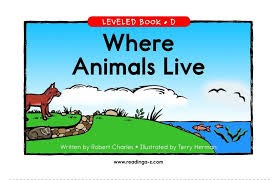

Ask children for the examples: What animals live in the air ?, What animals live on land ?, What animals live in the water?, What animals live underground? Write the answers on the board e.g. Birds live in the air, Cats and dogs live on land,Fish live in the water, Moles live underground. Children repeat the phrases after you 2 or three times, then they say them out loud on their own.
2. Discussion, speaking (5 min) Emphasize the fact that animals like humans live on the same planet - the Earth, which means we share the same 'home'. Ask children to think what they and animals need to live. Put their answers on the board and teach them:
Animals and people need air to live, Animals and people need food to live, Animals and people need water to live, Animals and people need a home to live. Remember that children repeat the phrases after you and then they say them out loud on their own.
3. Mini-scene, speaking (5 min) Put a sock on your hand and ask children to imagine this is an alien and the classroom is their own bedroom. The alien arrived to live in their home and misbehaves - throws litter all over the bedroom. Act it out - throw plastic bottles and bags around the classroom - on the desks and on the floor. Ask children: How do you feel - happy or sad, good or bad ? Help them to answer: We feel sad and bad. Add a rhyme: We feel sad and bad when the litter is around. Repeat the answer 2, 3 times. Put in on the board.
4. Writing and reading ( 10 min) Ask children to copy the sentences in their notesbooks. Then read them out loud as a class. Treat it as a chant.
Birds live in the air.
Cats and dogs live on land.
Fish live in the water.
Moles live underground.
Animals and people need air to live.
Animals and people need food to live.
Animals and people need water to live.
Animals and people need a home to live.
We feel sad and bad when the litter is around.
5.Photographs, listening (5 min) Explain to children that humans throw garbage into animals's homes: water, land and animals suffer from this. Some animals like birds and turtles eat waste and die. Use a simple language and mime as much as you can, so that children look, listen and undrestand. Illustrate the problem with photographs:
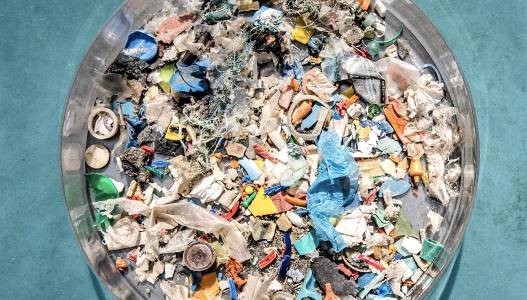
A sea turtle found in the Pacific Ocean had this debris in its stomach, according to The Ocean Cleanup, a foundation.
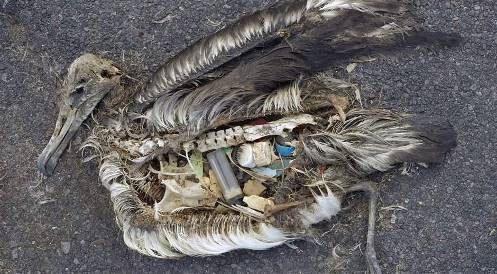
A dead albatross chick found on Midway Atoll in the Pacific Ocean with plastic debris in its stomach.
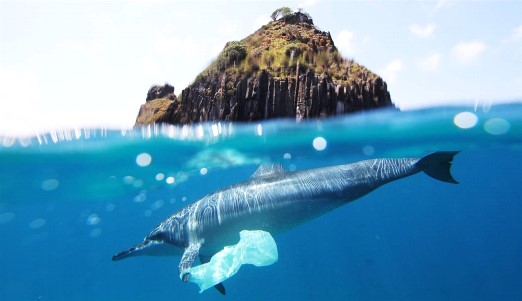
A dolphin with a plastic bag trailing from its fin swims in the Fernando de Noronha Archipelago in Brazil.
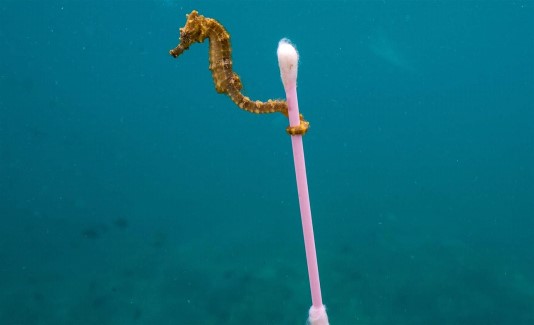
A seahorse wraps its tail around a plastic cotton swab near Sumbawa Island, Indonesia.
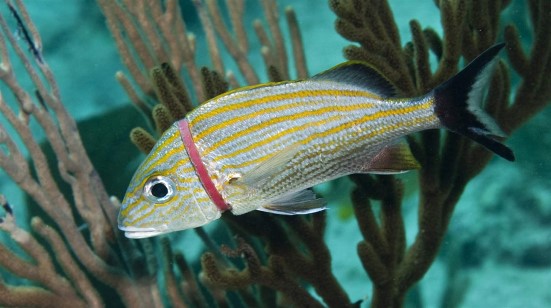
A plastic band restricts the growth of a blue-striped grunt fish in the Caribbean Sea.
The photos come from:
Let the children comment in their mother tongue. Then read the chant (4) out loud. You can ask children to read it out individually.
6.Video, listening,speaking. (6 min ) Show children the video, in which they will see the transformation of the thrown out flip flops into the production of things - animal toys and jewellery. Before watching tell them what they are going to see and ask them to watch for toy animals. You can stop the video on the 12th second and name the toy animals seen on the shelf. Pre-teach: flip-flops, jewellery.
https://www.youtube.com/watch?v=12V3u7bSTlI
After watching the video ask them about the boy. Ask them to try and guess what he was saying. Let them speak in their mother tonque and help say it in English. Ask if he felt happy or sad. Teach proud of. He is proud of making things from flip-flops. Children repeat and they say it on their own.
7. Summary, speaking. (8min) Summarize what you have seen and learnt - people who destroy animals' homes and people who 'repair the damage.' Ask children to decide what they prefer doing: destroying or taking care of the planet. Let children answer in their native language. To finish the lesson say the chant together, repeat a few times so that children memorize as much as possible.
8. Homework (1 min) Ask children to bring green and blue used plastic bags, a cardboard box, old glossy magazines for the next class.
Lessons 2 and 3
1. Introduction, speaking. (5 min) Start with saying the chant loud. Start as a choir and then encourage the children to try to say it individually. Reinforce them positively for their activity and attempt. Not only for the perfect result.
Explain to them that today, after watching the video, they are going to start working on a project on life under water in two groups. One group will be making an aquarium, another group will be making a poster.
2. Pre-teach the words (5 min): a starfish, a turtle, a jellyfish, a squid, an octopus, a shrimp, a seahorse, a clam, a manta ray, a crab, a seal, a flying fish, a dolphin, a whale, a shark and phrases:
move fast, see-through body, a bent body, an upright position, a hard shell, wings are huge, walk sideways, enjoy sunshine, is smart, breathe out, spout out water like a fountain, sharp teeth.
Use a method you like best: flashcards, drawing on the board, miming etc..
3. Video, listening (5 min) Play the video, children watch and listen. In review section (3,14 min) encourage children to repeat the names of sea animals.
https://www.youtube.com/watch?v=Oxw6FoUNeT4
4. Video, listening and reading. (8 min) Hand out the text of the recording. Ask children to listen and read (in silence) at the same time. It is a good idea to cover the screen, so children can just listen to the language. When the video is finished read the text together aloud as a class twice.
Hello, my name is Starfish.
Let me introduce you to my friends. Come with me!
starfish
A turtle moves fast in the sea.
turtle
A jellyfish has a see-through body.
jellyfish
A squid has 10 legs.
squid
Oh, this is an octopus! An octopus has 8 legs.
octopus
A shrimp has a bent body.
shrimp
A seahorse swims in an upright position.
seahorse
A clam has hard shells.
clam
Wow! The wings of a manta ray are really huge!
manta ray
A crab is walking sideways.
crab
A seal is enjoying the sunshine.
seal
A flying fish jumps in the air.
flying fish
Dolphins are very smart.
dolphin
When a whale breathes out, it spouts out water like a fountain!
whale
A shark has sharp teeth.
shark
Was this fun?
Did you have fun meeting my friends?
Next time, please introduce me to your friends! Bye, bye!
5. Project (55min) Divide the class into two groups - an aquarium group and a poster group. Each group needs to make one set of sea animals (15 animals in a set) out of colourful pieces of used magazines. An aquarium group needs to prepare 15 labels with animals’ names, a poster group needs to prepare 15 labels with the whole sentences from the text. Tell children to start with writing the labels and then move on to making animals. Let them organize who does what themselves.
First, they need to cut out colourful pieces from magazines.
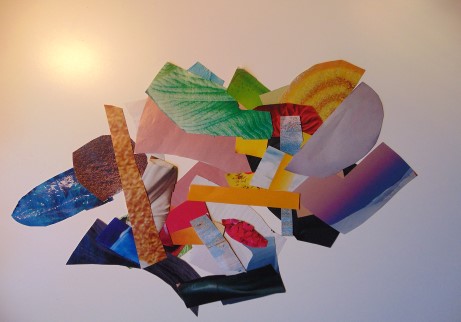
When making animals children can draw or use stencils if they feel like it. Give them the following handout with the silhouettes of sea animals to help them create.
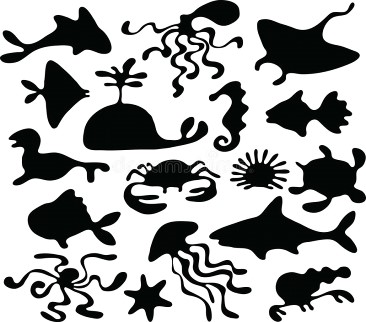
The picture comes from:
One group makes an aquarium out of a cardboard box. They can paint the inside and use plastic bags as water. Children hang ready sea animals on string. Air movement or blowing make the animals move, which is very appealing to children's imagination.
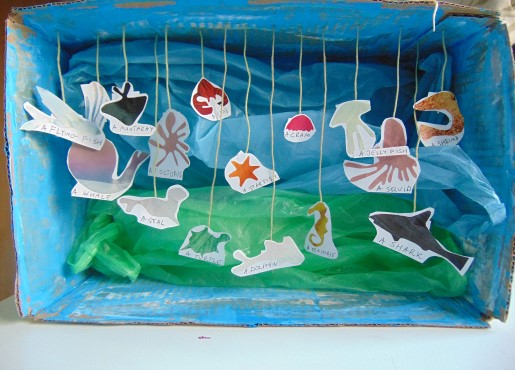
As for the poster, put plastic bags flat and pin them down to a display board. Then pin the sea animals with relevant sentences below each animal. Pin the chant from the previous lesson, too.
When children are working on projects, play the video so that they can listen again to the newly-learnt language. At the end the children tidy up their classroom.
6. Display part, (reading/speaking) (11 min)
Watch together the results of group work. Use the learnt language. Finish with saying the chant.
7. Homework (1 min)
Ask children to read the chant and the sentences a few times aloud, so they remember most of it.
Please check the How to Teach Environmental Studies course at Pilgrims website.
Please check the CLIL for Secondary course at Pilgrims website.
Global Goals Creatively: Animals - Our Friends
Sylwia Zabor-Zakowska, PolandGlocalization of Toruń Gingerbread Cookies
Elzbieta (Ela) Zielinska, Japan